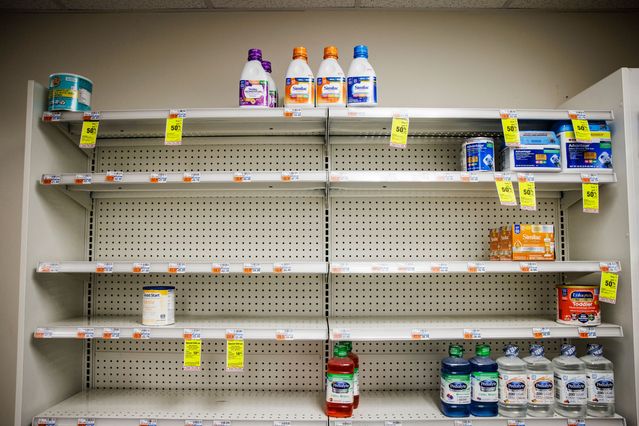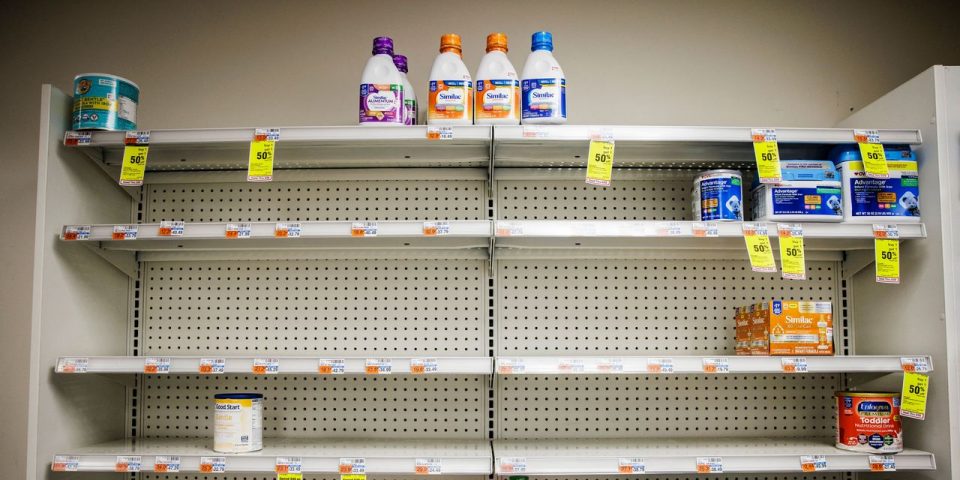Text size

Shelves normally meant for baby formula sit nearly empty at a store in downtown Washington, DC, on May 22, 2022.
Samuel Corum/AFP/Getty Images
About the authors: Tinglong Dai is a professor of operations management and business analytics at Johns Hopkins University’s Carey Business School and a core faculty member of the Hopkins Business of Health Initiative. Christopher S. Tang is a University Distinguished Professor and the Edward W. Carter Chair in Business Administration at the UCLA Anderson School of Management.
In merely two years, Americans have learned to normalize all sorts of product shortages. Even so, many were caught off guard by the ongoing baby formula crisis. It has threatened to deprive many American infants of their only source of nutrition, resulting in multiple hospitalizations.
As a temporary relief measure, military planes have been deployed to transport baby formula from Europe to the U.S. However, the crisis, along with other escalating supply chain issues, shows that the Biden administration needs to pay attention to improving the resilience of critical supply chains.
Paradoxically, no U.S. president in modern history has paid closer attention to supply chain issues than President Biden. During his first year in office, Biden signed an executive order to review supply chain security and named John Porcari as the White House port envoy. More recently, in March 2021, his team launched a new data initiative aimed at achieving greater supply chain resilience. On multiple occasions, he has defined the term “supply chain” precisely and eloquently as if he was a business professor.
Despite President Biden’s obsession with supply chains, the results are not flattering. And a majority of registered voters blame him for mishandling various supply chain problems.
Many have attributed the baby formula crisis to a lack of competition, overregulation, and the government nutrition program known as WIC. But the Food and Drug Administration’s failure to do its own job is the root cause.
The FDA failed to inspect the country’s largest baby formula factory in a timely and thorough manner, which set off the following chain reaction.
As early as 2019, the FDA learned that Abbott Laboratories’ baby formula plant in Sturgis, Mich., had poor quality control issues and that it found potentially lethal cronobacter bacteria in its products.
Even after it had received complaints that the milk formula produced by the Michigan plant may be unsafe, according to the Washington Post, the FDA did not inspect the factory for nearly two years, citing the Covid-19 pandemic as the reason for the halt in safety inspections. When it finally performed a routine inspection of the Abbott plant in September 2021, the FDA found new food safety issues and learned of more complaints about infants who became ill after drinking Abbott products. It did not include the complaints in the final notice, which would have been reviewed by FDA officials at the close of the inspection, according to the Washington Post.
Then, in October 2021, a whistleblower who previously worked at the Michigan factory reported serious safety violations. The FDA did not conduct another inspection at the plant until Jan. 31 2022, after an infant died after taking the formula made there. The next day, the FDA collected samples confirming cronobacter at the plant. Abbott submitted a corrective action plan to the FDA on April 8. “After a thorough review of all available data, there is no evidence to link our formulas to these infant illnesses,” Abbott said in a statement in May.
Baby formula is like drugs and vaccines, and safety violations are often the root cause of severe shortages. For example, the FDA suspended the biotech company Chiron’s license in 2004 after government inspectors discovered serious bacterial contamination at its Liverpool plant in the U.K., resulting in severe flu vaccine shortages of 50 million doses. Another case in point is Emergent BioSolutions’ Baltimore facility, which was forced to destroy nearly 400 million doses of Covid-19 vaccine for Johnson & Johnson due to safety violations that the company attempted to conceal.
To reduce the risk of shortages of baby formula and medical products, ensuring safety in these supply chains is of utmost importance. Drawing from the Toyota Production System, which is synonymous with the best quality control practice, the way to accomplish this is to fix problems as soon as they arise, at the source, wherever they may be.
The FDA did the exact opposite. Citing the pandemic, the FDA postponed a safety inspection of the Abbott factory in Michigan for two years. But this factory is the largest in America, producing approximately 20% of the baby formula sold in the U.S. market.
Allowing potentially unsafe products could harm many babies, and halting production could cause severe shortages of milk formula. And yet, the FDA was slow to inspect and failed to develop a contingency plan with Abbott to ensure milk formula safety and availability.
Today’s baby formula crisis could have been avoided had the FDA conducted a thorough safety inspection in 2019 and more frequent and thorough inspections since then. With today’s technology, the FDA can and should be able to monitor the operations of baby formula factories 24 hours a day, seven days a week.
The baby formula crisis is not an isolated incident. Throughout the pandemic, an alarming shortage of staff performing preventive maintenance at factories has resulted in a dramatic increase in fires and other disruptions across global supply chains. Investing in more frequent and extensive preventive maintenance can improve supply chain resilience, and the U.S. government can play an essential role.
The Biden administration has shown a strong desire to help improve supply chain resilience. Conducting more frequent and thorough safety inspections may not sound as sexy as other new initiatives, but it is probably the most effective way to improve supply chain resilience. This is the U.S. government’s job, and many modern technologies can assist it in doing so effectively.
Guest commentaries like this one are written by authors outside the Barron’s and MarketWatch newsroom. They reflect the perspective and opinions of the authors. Submit commentary proposals and other feedback to [email protected].


